Tunnelizing Migration 3: From Headwalls to Super Walls

[Image: An unrelated photo, via DJ_Scamper.]
It looks like the U.S. government is running a little back-to-basics sort of test in the nation’s backyard along the Arizona-Mexico border. They’ve selected a key 100-yard stretch of space right alongside the fence in Nogales to pack a concrete “headwall” 10-12 feet deep, 1-2 feet wide into the ground that will form essentially an invisible extension of the border fence below the surface.
According to the article, the headwall was poured “where smugglers have made several attempts over the years to dig through to the United States.” The Border Patrol accompanied Mexican officials along the wash that runs parallel to International Street in Mexico where they get through “along a stretch that is covered by concrete.”

[Image: A photo of the headwall in Nogales, Az. as it is being poured.]
So, they have turned to yet another wall in attempt to cut off the shallow subterrain of this popular stretch, but – will it succeed? In my measly opinion more than likely it will for a short term anyway, but not because of the new "headwall" but rather all the extra attention the area is receiving in general right now so that more likely the cartel will shift their operation elsewhere, at least until the Border Patrol looks away again. Yet, no doubt the BP will attribute credit to the headwall for suppressing the number of tunnels found there in the future, and use it as ammunition to clone the strategy elsewhere, who knows perhaps even as far away as Gaza (more on that later). In fact, merely weeks after the concrete has dried, the Border Patrol is already claiming it a success, saying so far they haven’t found any new tunnels. Ha! Hilarious – it’s only been a few weeks!
I would be even less surprised if in a few more weeks from now they found a new tunnel stretching below, or even right through it.

[Image: A photo of the headwall in Nogales, Az. as it is being poured.]
From what I’ve read in the past tunnelers have been known to reuse the concrete from the Customs and Border Protection’s plugs in order to support new passages. Often just offshoots of old existing tunnels, the BP will tell you, some of which are kept semi in tact like pregnant voids cut off inside the border at both ends; concretized air bubbles trapped below the earth’s surface. I also read a while back that to counter this move they were developing a special concrete that would crumble if tampered with, and using slurry so the plugs might cave in on tunnelers as well.
Yet, in trying to look at this from the DHS's perspective, my first reaction to an underground wall is: won’t this also just help the tunnelers by feeding them added raw material to work with? And wouldn’t it provide additional cover from other detection methods – especially if they’ve already been successful puncturing concrete?
Of course, the obvious lesson to me here is, you don’t solve the inherent fallacy of a wall by adding more walls. But, if there is one thing we can say about American policy in this regard, it is the kind of hardheadedness that perhaps only a headwall can do justice.
All I can say is, mustn’t underestimate the ingenuity of the cartel, or even the noble migrant seeking access to a better livelihood, for that matter. Now that it’s getting down to pitching shovels the size of football fields into the crawl spaces of the earth’s crust, what next? How deep do they plan for their underground wall to go?
In an unapologetically farcical portrayal of a future here, this roughly 3500 sq. ft. concrete headwall would only mark the tip of an iceberg – in reality, the tip of an impossibly extended manmade iceberg, since this headwall would be the first of many concrete sheets just like it to follow in its footsteps and be fed into the earth, numbered and mapped like an impenetrable storage system made for filing walls into the border. All part of an international project the leaders of global defense one day sought to supplant, in key locations at first – “an intelligent super wall” (as it had once been called) that would be built entirely underground (yes, underground), as a kind of sepulcherous megastructure; an anti cross-border tunnel fence, in more mundane terms, delineating national boundaries somewhat in secret along a deceptively hardened equator that would be (and get this) capable in its final stages of production of “shuffling giant reinforced concrete panels around inside the earth on hydraulics, magnets, and flexible tracks that would build itself like a web.” Apparently, at the behest of some nifty software it would also “constantly dig and recede deeper into the earth” below Hades’ own horizons where even “the roguest of rogue engineers working for the cartel would never be able to dig.”
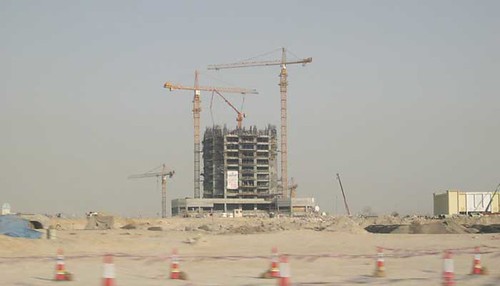
[Image: A photo from Dubai.]
At the annual meeting of the 46th World Futurological Congress that took place inside an old half-built luxury condo tower that had been surgically dismantled on an abandoned site in Dubai, trucked and shipped in elephantine parts overseas to a small town outside of Nogales that was recently renamed Moho Vista, where the old condo’s side walls fifteen stories long and decapitated roof had been lifted by a new German breed of walking cranes and submerged vertically underground into these massive gills the Army Corps of Engineers spent months excavating right beside the border fence, the leading thinkers on global security had come together to observe what was formally ordained the first observational bunker for the work and testing being done on this new Great Wall project, that had not received much of anyone’s attention up to this point.
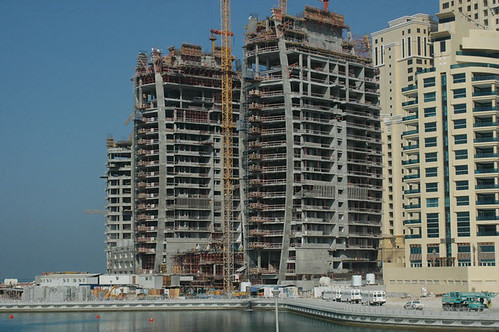
[Image: A photo from Dubai.]
It was here inside the architectural refuse of Dubai’s cosmopolitan ruins sunken in the ground where some of the dirtiest martinis were still served with napkins that had a cryptic drill-bit for a logo you could have easily mistaken for a mutant stingray or a flat-nosed hard-on of some kind militarized with earth crushing teeth, the chief heads of defense staff and their robotic secretaries had been sent to see firsthand how such a subterranean super wall might actually work towards helping to alleviate the persistent political aches of unsecured borders routinely taken over by highly sophisticated criminal elements.
As they wandered around inside the desiccated wet dreams of a far-off real estate mogul from a short past whose project had finally been relieved of its costly futility by way of burial now, the eyes and ears of the Congress were completely stunned to see the meticulous inner workings of this embedded laboratory which surprisingly only required a staff of 22 people to operate with optimal efficiency, where the hulks of busted buildings lay in wait on the surface in a storage yard for the next phase of assembly line to take hold and deliver them into an incredible handling system through landscape cuts and sculpted fissures held together by what looked like the brilliant network of diseased steel tracks and magnetic clasps moving on hydraulic spokes that might have even made Lebbeus Woods cringe with amazement.

[Image: The wall of the Bosnia Free State, by Lebbeus Woods.]
It was the greatest disappearing act you’d ever see – entire building broken down and swallowed by the earth. It had the simplicity of an IKEA living room lighting system that could be situated in various locations by gliding easily in any directions on a set of crisscrossed wires similar to the NFL’s silky smooth SkyCam, and the incomprehensible wonder and logic of a vortexual system that couldn’t be fully grasped visually because all of its parts at once seemed simply overwhelming. It looked like it had been designed to install panels the size of football fields or sidewalk squares depending on the need.
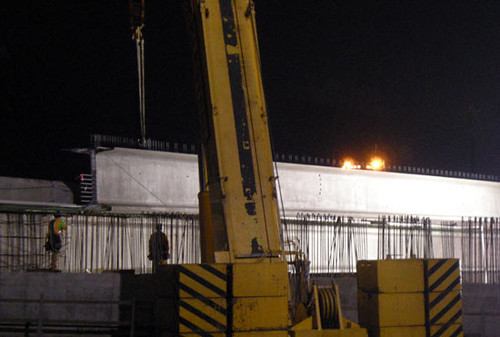
[Image: An unrelated construction photo.]
What they saw were the first rooted machinations of “a self-mining self-organizing wall-works system” that would allow just a handful of engineers to “feed in recycled slab and scavenged structural parts at ground level like cd’s into a multidisc player” before being conjoined again “in Tetris-like fashion” to create a new kind of barrier no one has ever seen before. The system was already performing some basic shuffling patterns pulling from a daisy chain of dislocated walls of various sizes and shapes accessed from a meticulously well-wired and imperceptibly long cavernous vault underground. It was kind of like mining a giant jukebox into the earth that swapped massive records of concrete underground instead of old vinyl by your table. The system kept exact measurements of all the sectional dimensions and weights before they were inserted so that each one (as it were) could be selected and appropriately fitted into specific excavated niches based on the spatial allowances the drilling machines were able to negotiate at the time.
In the project’s brochure the ‘observational bunker’ was pictured as being mobile and able to traverse along the wall in all directions on its own set of cables like an architectural labyrinthine spider. In some smaller renderings it was shown perched at a generic set of coordinates to inspect “unintended” gaps and maintain infrastructure, while in another image the engineers were using the sampled condo bunker to reach a clandestine tunnel they were plugging with some sort of indestructible mesh and concrete.
It was an incredible vision and the Congress was speechless watching gargantuan walls shifting in and out of place on an ingeniously compact frame that was fitted and secured with exceptional robotic engineering, while great booring snake heads chewed deeper into the earth below preparing for the next tectonic shifts in the wall’s invisible expansion. The underground wall would be able to maneuver itself down to depths of several hundred feet the first year, the Congress was told, they were going slowly to be safe, led by a set of smaller more durable panels that would slide down first behind the drills with every new depth change, “so the larger panels could slowly move down in their place.” It was a domino effect of walls falling into the earth, fastening and securing themselves into a kind of subtopic belt.
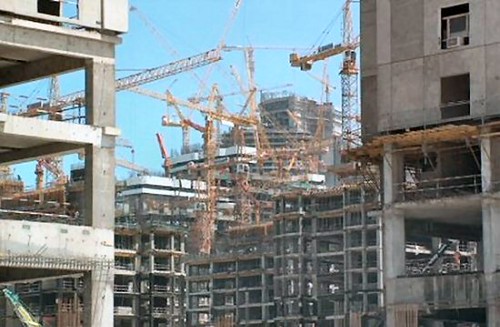
[Image: A photo from Dubai.]
In fact, after a brilliant briefing by a squirrelly planner named Chip who worked for a private agency chosen to lead the new Tectonic Warfare Task Force, who showed off what at first appeared completely laughable proposals for ways his demolition crews could not only scavenge but largely repurpose several different types of structural remains littering the world from shopping malls, substations and power plants to warehouses, abandoned railway tunnels and decrepit prisons, the Congress voted overwhelmingly in favor of funding the next phase of the project and leapt at the idea of using the Underground Wall to spur a new industrial boom that would capitalize not on building per se, so much as on hyping a responsible deconstruction of society’s decommissioned ruins, by breaking them down into valuable fortification materials, and relocating them deep inside the contentious seams of regional border zones where a “chain of superficial perforations” would be dug and the underground panels could be distributed to their new positions safeguarding the wealthy nations from below.
It was a mouthful. And, “it was like treating the earth for cavities,” Chip said, “we see ourselves as large scale dentists in this great endeavor, attacking the criminal tunnel networks where they’re known to exist or are still considered likely before they spread.” And he was creating a kind of cemetery to late capitalism in the process, helping to dispose of the urban shells left in the economy’s deflated wake. And right towards the end of his briefing, just to give the Congress that extra thump over the head he said, “Oh, and a combination of the wall’s flexibility afforded by our innovative mesh and the ability to fasten the whole thing on revolutionary new vibration dampeners will allow each separate structure to independently absorb and adjust to the earth’s routine shifts and movements. So, in case you were wondering,” the planner assured them, “earthquakes are our friends. They actually help tighten the wall’s pieces together.”

[Image: An unrelated photo.]
For the time being he had dodged any questions about whether slicing the earth’s crust in half might actually cause any earthquakes, and quickly handed out business cards on a translucent paper to everyone while shaking hands and generally feeling like an underground rockstar.
On paper, it was a marvelous feat of military engineering that imagined an infinite concrete wall stretching and sinking as if it were its own tectonic plate sliding along a seismically reinforced axis that would shut the curtain on the underground forever to come, which had brought everyone on board from national security experts to mining gurus, real estate speculators and engineers, global steel companies, private prison operators, geography professors and their gangly grad students, hordes of environmental activists with telescopes and loudspeakers, Native American spiritual leaders, corporate lobbyists, hard headed politicians, conspiracy tweaks, conmen and madmen, all the way down to the average Joe construction worker – they all wanted a piece of this new subterranean boom and in some strange way it had a place for each and every one of them. There was no one who wasn’t curious enough to go see this thing for himself from as close as he could get once word broke out the U.S. was stashing old buildings below the border for some sort of national security project. It wouldn’t be long before small armies of RV’s would turn up dotting ridges and pooling in valleys to launch their cell phone based tourist maps of the restricted areas.
Securing the Homeland to the Core became a kind of generic mantra over time that ended up printed on thousands of coffee mugs in cubicles worldwide, on T-shirts and for for sale on Ebay, on new and strange product packaging which soon emerged from all of this: weird energy drinks that supposedly increased the health of your pupils, flavored oxygen inhalers, glow in the dark bubble gums. Tunnel rat junk foods.
The idea, though, that globalization’s extinct structures could be recompiled into a new Great Anti-Tunnel Wall underground “to put organized crime back in its place,” was simply too mouth-watering for the participants of the Futurological Congress to disapprove.
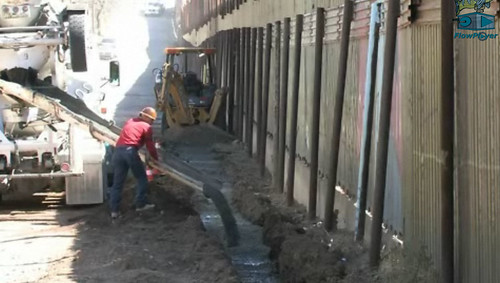
[Image: A photo of the headwall in Nogales, Az. as it is being poured.]
Hailed as “the answer” to groups of “international outlaws” and “cowardly terrorists” who have “taken refuge under our borders for far too long,” in the end the planner had sold the leaders of the world on the simple concept of a titanic barrier sinking towards the bottom of the earth, defying geological convention, spreading horizontally like thieving waves that would remain permanently just under the surface to stem the tunnely platitudes and seamy sanctuaries of the violent and rapacious cartel.
And just as security bureaucrats had given into the incontrovertible reality of the border fence having miserably failed as a consequence to “illegal immigration,” this new plan was set to revive their hopes all over again and redeem what had seemed irredeemable to the public who spent billions already on the legacy of a juvenile and ill-fated strategy for years. This time the border fence would do what it was meant to do, they said, this was the most formidable security structure ever conceived or ever built, and it was going to be a complete and total future archaeological wonder of the world one day that had already brought the Pentagon to its knees upon seeing walls fed into the earth as easy as a giant toaster, who signed off on it even before the precautious little planner had to ask if there were any questions. The postcards had already been sent to the printer. There was no way this thing could lose, was the caption that hung over everyone’s head that afternoon walking out of there.
Of course, how it all turned out, was, well, a different story, as you might imagine.
Part 4 coming soon. Oh, so is part 2.
Read: Tunnelizing Migration 1: The Border Tunnel Capital of North America
Video: Walls beget tunnels and tunnels beget walls







5 Comments:
This subterrainian wall makes me think of two things:
the corp of engineers' work in post-katrina new orleans (which has gone deeper? which will hold back its respective tide more effectively? are there inter-service rivalries that essentially equate migrants and storm surges, and do they offer one-downing stories of despair in "combating" them?)
and
are they examining the hydrological data when they make these things? could these "extreme" footings vector the aquafers in a way that hastens the undermining of the wall?
and
its like an odd, orthogonal installation of a 2-lane road. to the degree that cars can't actually drive on it and they don't encourage sprawl, i like 'em!
I like the connection to the post-Katrina construction; it’s like a buried levee system, one that can only equally fail by sheer virtue of its inadequate design to begin with.
But, perhaps it is not immune to sprawl. What if the future will spell a sprawl of informal settlements and security zones underground, as sea levels rise land space grows scarce, there are layers of retreats to the underground of higher soils. As aerial surveillance becomes even more ubiquitous, people for the sake of protecting their rights to privacy will be forced to reside the only place left to escape laboratory view.
Mass exoduses towards the center of the earth; new state systems founded in networks of tunnels and caves, colonies born in reflective light, refugee camps and gated communities side-by-side 150 feet below the dirt separated by a buried and decaying wall; new service industries that move through the cracks, solar powered lighting companies boom.
Yes, certainly, the wall itself is and has to be it’s own undoing. While civilization may rest on an urban DNA of walls I don’t think it’s wrong to say there’s something much too liberal about their deployment to resolve every single crisis that is not even architectural but strictly political. Walls might structure space, but should they architect politics?
No matter how creative they think they may be with their walls, floating fences, virtual fences, over ground or below it, the wall when not the answer is nothing but a slope towards inevitable disaster – it’s the structure of postponement; debt deferral. It’s the symbol of our times.
layers of retreats to the underground of higher soils: yes!
there are a number of non-military efforts in that direction: "green" regulatory efforts promoting green roofs as virtual, artificial landscapes & aquifers; solar initiatives that will demand, for industrial production, enormous tracts of land and may find habitable space beneath them.
And, from the military vantage, the shell game that boeing pulled in WWII (coating their enormous roof with a fake town to avoid detection from the air) might have been a prelude to much greater things to come. I think of Ford's "greening" of their SUV toxic facility by putting a "green" roof over it (ie 2' of sod on top of an impervious concrete slab) - the time is ripe for that solution to expand, answering the greenies & the military's desires at once - what is Renzo's new Cal Science bldg if not the underground retreat to higher soils?
which brings another thought on these buried levees: linear monuments to the bath-tub at the world trade center, the nation defined by a 20,000mile perimeter bathtub. the walls of the future, like the subterrainian dwellings in China (or Uncle Owen's house on Tatooine)
I'm interested in the potential automation of it (like a sort've diabolical version of one of Jansen's Strandbeests).
Over time, people don't even control it anymore. It's more of a machine with a set of instructions that make it self-perpetuating. It's smart enough to find hidden oil repositories and blocks of limestone (for concrete) deep below the earth. Perhaps several of them are made and then forgotten about.
A century later, people have migrated underground, and we have a "Tremors" situation. The world looks on in horror as the machine gobbles up people and homes and replaces them with 8 foot thick concrete walls... the sins of the father visited upon his great, great, great grandchildren.
Or what if it built damns in the upper mantel, disrupting magma oceans and spawning new volcanoes? Maybe the congress uses it as a weapon to create seismic and volcanic activity beneath hostile countries.
Yeah man, great metaphor.
Dear representative of Subtopia,
We are organizing the 3rd Advanced Architecture Contest under the topic THE SELF-SUFFICIENT CITY, envisioning the habitat of the future.
The aim of this international competition is to promote online discussion and research through which to generate insights and visions, ideas and proposals that help us envisage what the city and the habitat of the 21st century will be like.
The competition is open to architects, planners, designers and artists who want to contribute to progress in making the world more habitable by developing a proposal capable of responding to emerging challenges in areas such as ecology, information technology, socialization and globalization, with a view to enhancing the connected self-sufficiency of our cities.
We would appreciate if you could provide this information to your users, as we think this project is an opportunity to exchange ideas with the rest of our international architecture community.
We would also like to send you a physical poster of the event; for this purpose could you please send us your postal address.
We have also enclosed a copy of the poster in two different definitions, print and web.
Thank you and Best regards
Marie Jacquinet
Communication Manager
3rd Advanced Architecture Contest
contact@advancedarchitecturecontest.org
http://www.advancedarchitecturecontest.org/
Organized by
Institute for Advanced Architecture of Catalonia
http://www.iaac.net/
Post a Comment
<< Home